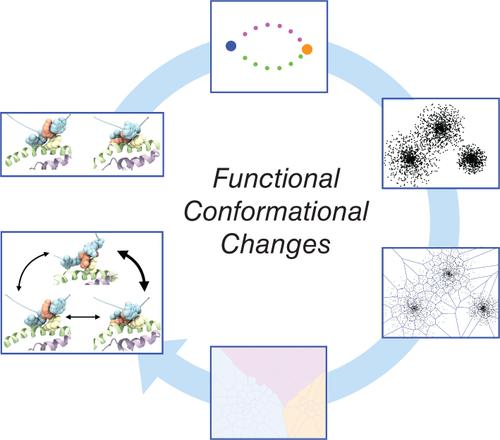当前位置:
X-MOL 学术
›
WIREs Comput. Mol. Sci.
›
论文详情
Our official English website, www.x-mol.net, welcomes your
feedback! (Note: you will need to create a separate account there.)
Constructing Markov State Models to elucidate the functional conformational changes of complex biomolecules
Wiley Interdisciplinary Reviews: Computational Molecular Science ( IF 16.8 ) Pub Date : 2017-10-06 , DOI: 10.1002/wcms.1343 Wei Wang 1, 2 , Siqin Cao 1 , Lizhe Zhu 1, 2 , Xuhui Huang 1, 2, 3, 4
Wiley Interdisciplinary Reviews: Computational Molecular Science ( IF 16.8 ) Pub Date : 2017-10-06 , DOI: 10.1002/wcms.1343 Wei Wang 1, 2 , Siqin Cao 1 , Lizhe Zhu 1, 2 , Xuhui Huang 1, 2, 3, 4
Affiliation

|
The function of complex biomolecular machines relies heavily on their conformational changes. Investigating these functional conformational changes is therefore essential for understanding the corresponding biological processes and promoting bioengineering applications and rational drug design. Constructing Markov State Models (MSMs) based on large‐scale molecular dynamics simulations has emerged as a powerful approach to model functional conformational changes of the biomolecular system with sufficient resolution in both time and space. However, the rapid development of theory and algorithms for constructing MSMs has made it difficult for nonexperts to understand and apply the MSM framework, necessitating a comprehensive guidance toward its theory and practical usage. In this study, we introduce the MSM theory of conformational dynamics based on the projection operator scheme. We further propose a general protocol of constructing MSM to investigate functional conformational changes, which integrates the state‐of‐the‐art techniques for building and optimizing initial pathways, performing adaptive sampling and constructing MSMs. We anticipate this protocol to be widely applied and useful in guiding nonexperts to study the functional conformational changes of large biomolecular systems via the MSM framework. We also discuss the current limitations of MSMs and some alternative methods to alleviate them. WIREs Comput Mol Sci 2018, 8:e1343. doi: 10.1002/wcms.1343
中文翻译:

建立马尔可夫状态模型以阐明复杂生物分子的功能构象变化
复杂的生物分子机器的功能在很大程度上取决于其构象变化。因此,研究这些功能性构象变化对于理解相应的生物过程,促进生物工程应用和合理的药物设计至关重要。基于大规模分子动力学模拟构建马尔可夫状态模型(MSM)已成为一种强大的方法,可以在时间和空间上以足够的分辨率对生物分子系统的功能构象变化进行建模。但是,用于构建MSM的理论和算法的飞速发展使非专业人员难以理解和应用MSM框架,因此必须对其MSM的理论和实际使用进行全面的指导。在这项研究中,我们介绍了基于投影算子方案的MSM构象动力学理论。我们进一步提出了构建MSM的通用协议以研究功能构象变化,该协议集成了用于构建和优化初始路径,执行自适应采样和构建MSM的最新技术。我们预计该协议将被广泛应用,并通过MSM框架指导非专家研究大型生物分子系统的功能构象变化。我们还将讨论MSM的当前局限性以及减轻它们的一些替代方法。它集成了用于构建和优化初始路径,执行自适应采样和构建MSM的最新技术。我们预计该协议将被广泛应用,并通过MSM框架指导非专家研究大型生物分子系统的功能构象变化。我们还将讨论MSM的当前局限性以及减轻它们的一些替代方法。它集成了用于构建和优化初始路径,执行自适应采样和构建MSM的最新技术。我们预计该协议将被广泛应用,并通过MSM框架指导非专家研究大型生物分子系统的功能构象变化。我们还将讨论MSM的当前局限性以及减轻它们的一些替代方法。电线计算科学2018,8:e1343。doi:10.1002 / wcms.1343
更新日期:2017-10-06
中文翻译:

建立马尔可夫状态模型以阐明复杂生物分子的功能构象变化
复杂的生物分子机器的功能在很大程度上取决于其构象变化。因此,研究这些功能性构象变化对于理解相应的生物过程,促进生物工程应用和合理的药物设计至关重要。基于大规模分子动力学模拟构建马尔可夫状态模型(MSM)已成为一种强大的方法,可以在时间和空间上以足够的分辨率对生物分子系统的功能构象变化进行建模。但是,用于构建MSM的理论和算法的飞速发展使非专业人员难以理解和应用MSM框架,因此必须对其MSM的理论和实际使用进行全面的指导。在这项研究中,我们介绍了基于投影算子方案的MSM构象动力学理论。我们进一步提出了构建MSM的通用协议以研究功能构象变化,该协议集成了用于构建和优化初始路径,执行自适应采样和构建MSM的最新技术。我们预计该协议将被广泛应用,并通过MSM框架指导非专家研究大型生物分子系统的功能构象变化。我们还将讨论MSM的当前局限性以及减轻它们的一些替代方法。它集成了用于构建和优化初始路径,执行自适应采样和构建MSM的最新技术。我们预计该协议将被广泛应用,并通过MSM框架指导非专家研究大型生物分子系统的功能构象变化。我们还将讨论MSM的当前局限性以及减轻它们的一些替代方法。它集成了用于构建和优化初始路径,执行自适应采样和构建MSM的最新技术。我们预计该协议将被广泛应用,并通过MSM框架指导非专家研究大型生物分子系统的功能构象变化。我们还将讨论MSM的当前局限性以及减轻它们的一些替代方法。电线计算科学2018,8:e1343。doi:10.1002 / wcms.1343











































 京公网安备 11010802027423号
京公网安备 11010802027423号